Abstract
The effects of the Na+ gradient and pH on phosphate uptake were studied in brush-border membrane vesicles isolated from rat kidney cortex. The initial rates of Na(+)-dependent phosphate uptake were measured at pH 6.5, 7.5 and 8.5 in the presence of sodium gluconate. At a constant total phosphate concentration, the transport values at pH 7.5 and 8.5 were similar, but at pH 6.5 the influx was 31% of that at pH 7.5. However, when the concentration of bivalent phosphate was kept constant at all three pH values, the effect of pH was less pronounced; at pH 6.5, phosphate influx was 73% of that measured at pH 7.5. The Na(+)-dependent phosphate uptake was also influenced by a transmembrane pH difference; an outwardly directed H+ gradient stimulated the uptake by 48%, whereas an inwardly directed H+ gradient inhibited the uptake by 15%. Phosphate on the trans (intravesicular) side stimulated the Na(+)-gradient-dependent phosphate transport by 59%, 93% and 49%, and the Na(+)-gradient-independent phosphate transport by 240%, 280% and 244%, at pH 6.5, 7.5 and 8.5 respectively. However, in both cases, at pH 6.5 the maximal stimulation was seen only when the concentration of bivalent trans phosphate was the same as at pH 7.5. In the absence of a Na+ gradient, but in the presence of Na+, an outwardly directed H+ gradient provided the driving force for the transient hyperaccumulation of phosphate. The rate of uptake was dependent on the magnitude of the H+ gradient. These results indicate that: (1) the bivalent form of phosphate is the form of phosphate recognized by the carrier on both sides of the membrane; (2) protons are both activators and allosteric modulators of the phosphate carrier; (3) the combined action of both the Na+ (out/in) and H+ (in/out) gradients on the phosphate carrier contribute to regulate efficiently the re-absorption of phosphate.
Full text
PDF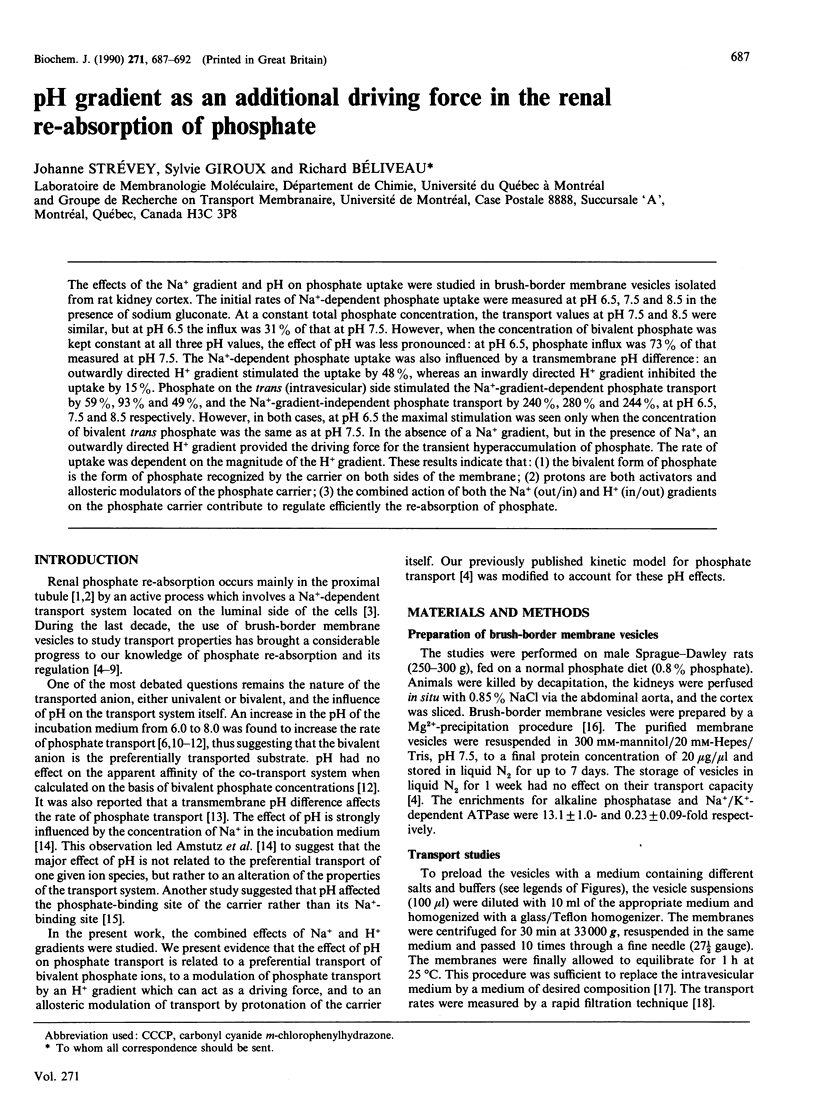
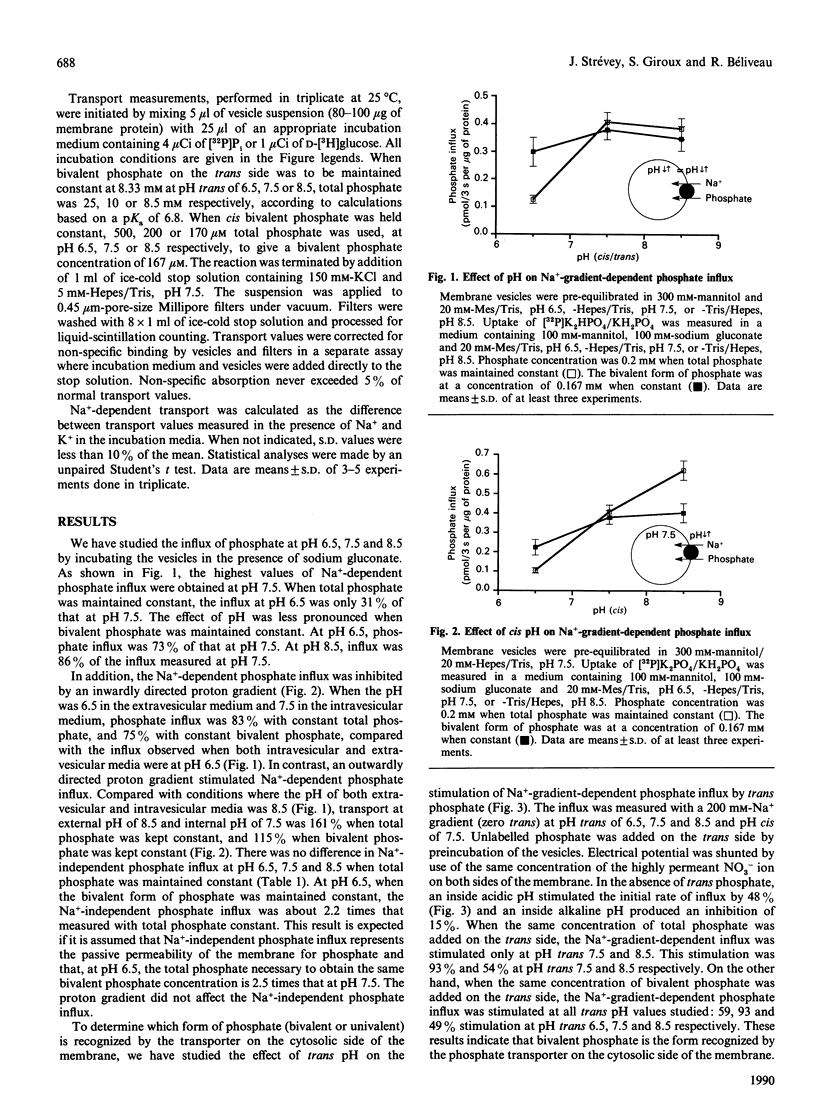
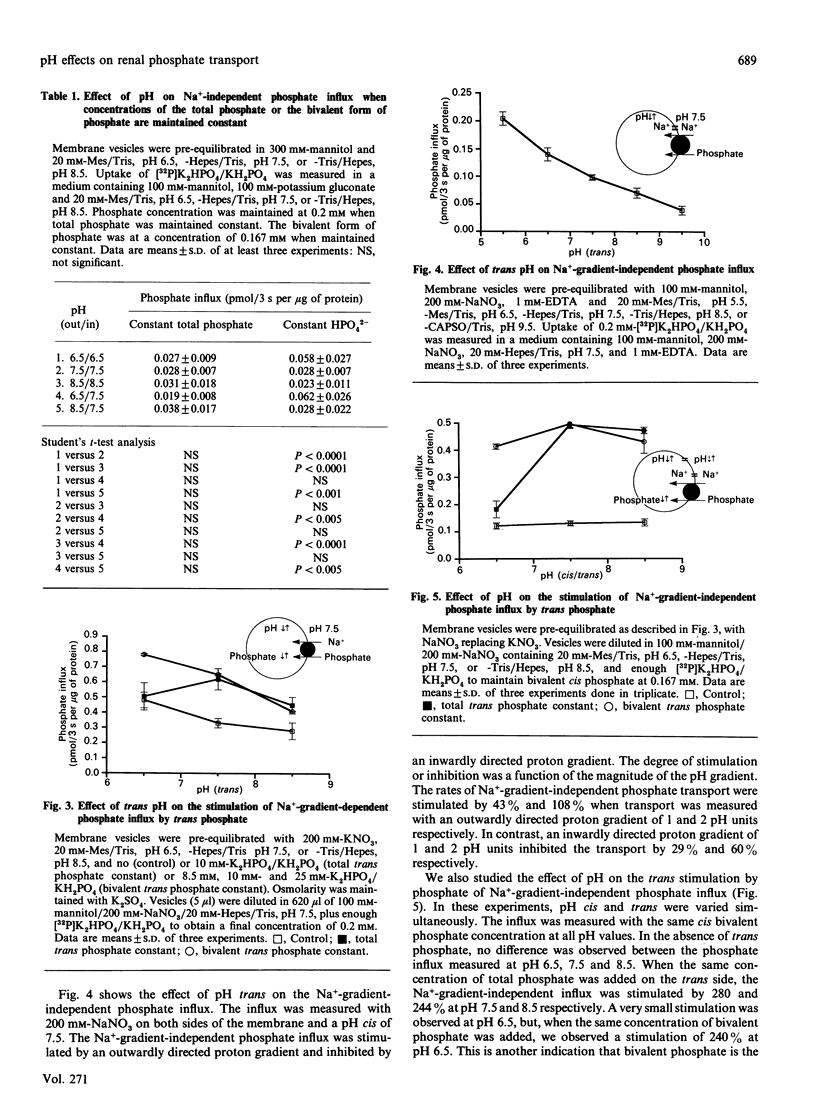
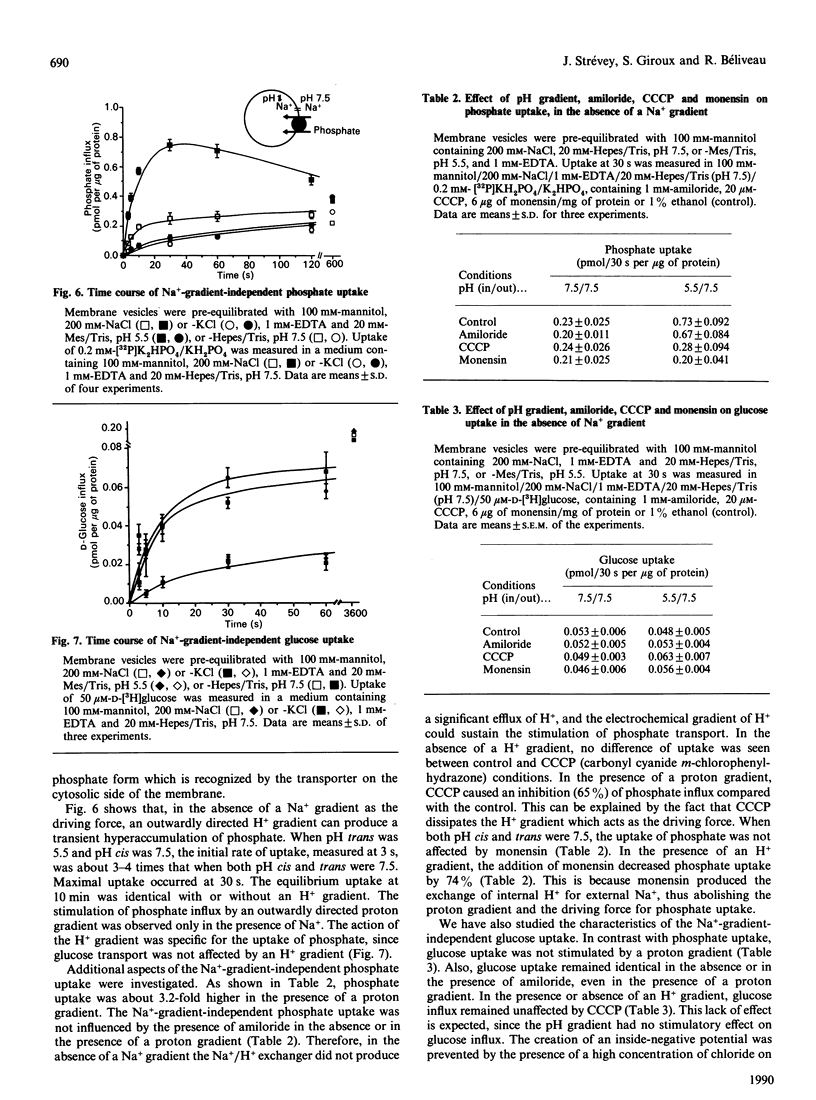

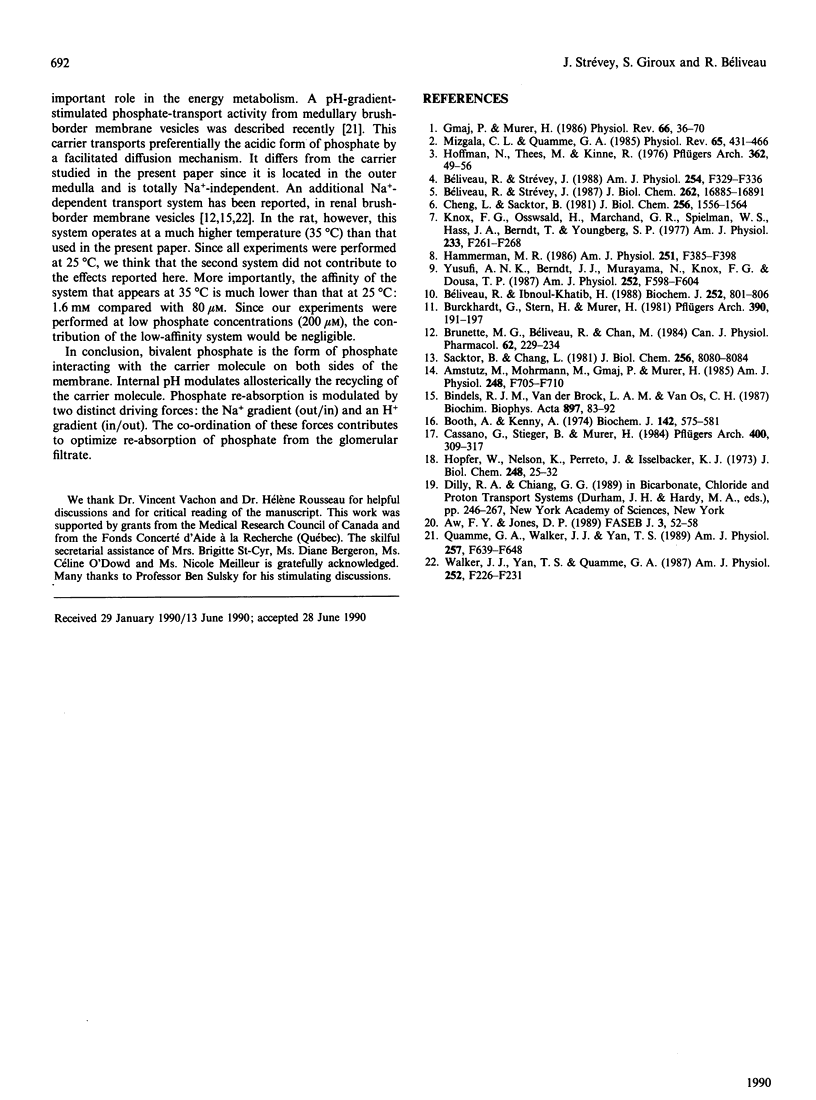
Selected References
These references are in PubMed. This may not be the complete list of references from this article.
- Amstutz M., Mohrmann M., Gmaj P., Murer H. Effect of pH on phosphate transport in rat renal brush border membrane vesicles. Am J Physiol. 1985 May;248(5 Pt 2):F705–F710. doi: 10.1152/ajprenal.1985.248.5.F705. [DOI] [PubMed] [Google Scholar]
- Aw T. Y., Jones D. P. Heterogeneity of pH in the aqueous cytoplasm of renal proximal tubule cells. FASEB J. 1989 Jan;3(1):52–58. doi: 10.1096/fasebj.3.1.2910737. [DOI] [PubMed] [Google Scholar]
- Bindels R. J., van den Broek L. A., van Os C. H. Effect of pH on the kinetics of Na+-dependent phosphate transport in rat renal brush-border membranes. Biochim Biophys Acta. 1987 Feb 12;897(1):83–92. doi: 10.1016/0005-2736(87)90317-8. [DOI] [PubMed] [Google Scholar]
- Booth A. G., Kenny A. J. A rapid method for the preparation of microvilli from rabbit kidney. Biochem J. 1974 Sep;142(3):575–581. doi: 10.1042/bj1420575. [DOI] [PMC free article] [PubMed] [Google Scholar]
- Brunette M. G., Beliveau R., Chan M. Effect of temperature and pH on phosphate transport through brush border membrane vesicles in rats. Can J Physiol Pharmacol. 1984 Feb;62(2):229–234. doi: 10.1139/y84-034. [DOI] [PubMed] [Google Scholar]
- Burckhardt G., Stern H., Murer H. The influence of pH on phosphate transport into rat renal brush border membrane vesicles. Pflugers Arch. 1981 May;390(2):191–197. doi: 10.1007/BF00590206. [DOI] [PubMed] [Google Scholar]
- Béliveau R., Ibnoul-Khatib H. Electrogenicity of phosphate transport by renal brush-border membranes. Biochem J. 1988 Jun 15;252(3):801–806. doi: 10.1042/bj2520801. [DOI] [PMC free article] [PubMed] [Google Scholar]
- Béliveau R., Strevey J. The sodium gradient induces conformational changes in the renal phosphate carrier. J Biol Chem. 1987 Dec 15;262(35):16885–16891. [PubMed] [Google Scholar]
- Béliveau R., Strévey J. Kinetic model for phosphate transport in renal brush-border membranes. Am J Physiol. 1988 Mar;254(3 Pt 2):F329–F336. doi: 10.1152/ajprenal.1988.254.3.F329. [DOI] [PubMed] [Google Scholar]
- Cassano G., Stieger B., Murer H. Na/H- and Cl/OH-exchange in rat jejunal and rat proximal tubular brush border membrane vesicles. Studies with acridine orange. Pflugers Arch. 1984 Mar;400(3):309–317. doi: 10.1007/BF00581565. [DOI] [PubMed] [Google Scholar]
- Cheng L., Sacktor B. Sodium gradient-dependent phosphate transport in renal brush border membrane vesicles. J Biol Chem. 1981 Feb 25;256(4):1556–1564. [PubMed] [Google Scholar]
- Gmaj P., Murer H. Cellular mechanisms of inorganic phosphate transport in kidney. Physiol Rev. 1986 Jan;66(1):36–70. doi: 10.1152/physrev.1986.66.1.36. [DOI] [PubMed] [Google Scholar]
- Hammerman M. R. Phosphate transport across renal proximal tubular cell membranes. Am J Physiol. 1986 Sep;251(3 Pt 2):F385–F398. doi: 10.1152/ajprenal.1986.251.3.F385. [DOI] [PubMed] [Google Scholar]
- Hopfer U., Nelson K., Perrotto J., Isselbacher K. J. Glucose transport in isolated brush border membrane from rat small intestine. J Biol Chem. 1973 Jan 10;248(1):25–32. [PubMed] [Google Scholar]
- Knox F. G., Osswald H., Marchand G. R., Spielman W. S., Haas J. A., Berndt T., Youngberg S. P. Phosphate transport along the nephron. Am J Physiol. 1977 Oct;233(4):F261–F268. doi: 10.1152/ajprenal.1977.233.4.F261. [DOI] [PubMed] [Google Scholar]
- Mizgala C. L., Quamme G. A. Renal handling of phosphate. Physiol Rev. 1985 Apr;65(2):431–466. doi: 10.1152/physrev.1985.65.2.431. [DOI] [PubMed] [Google Scholar]
- Quamme G. A., Walker J. J., Yan T. S. pH gradient-stimulated phosphate transport in outer medullary brush-border membranes. Am J Physiol. 1989 Oct;257(4 Pt 2):F639–F648. doi: 10.1152/ajprenal.1989.257.4.F639. [DOI] [PubMed] [Google Scholar]
- Sacktor B., Cheng L. Sodium gradient-dependent phosphate transport in renal brush border membrane vesicles. Effect of an intravesicular greater than extravesicular proton gradient. J Biol Chem. 1981 Aug 10;256(15):8080–8084. [PubMed] [Google Scholar]
- Walker J. J., Yan T. S., Quamme G. A. Presence of multiple sodium-dependent phosphate transport processes in proximal brush-border membrane. Am J Physiol. 1987 Feb;252(2 Pt 2):F226–F231. doi: 10.1152/ajprenal.1987.252.2.F226. [DOI] [PubMed] [Google Scholar]
- Yusufi A. N., Berndt T. J., Murayama N., Knox F. G., Dousa T. P. Calcitonin inhibits Na+ gradient-dependent phosphate uptake across renal brush-border membranes. Am J Physiol. 1987 Apr;252(4 Pt 2):F598–F604. doi: 10.1152/ajprenal.1987.252.4.F598. [DOI] [PubMed] [Google Scholar]


